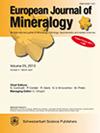The effect of chemical variability and weathering on Raman spectra of enargite and fahlore
IF 1.7
3区 地球科学
Q2 MINERALOGY
引用次数: 0
Abstract
Abstract. Enargite (Cu3AsS4) and tennantite (Cu12As4S13) are typical As-bearing sulfides in intermediate- and high-sulfidation epithermal deposits. Trace and major element variations in enargite and tennantite and their substitution mechanisms are widely described. However, Raman spectra of the minerals with correlative quantitative chemical information are rarely documented, especially for enargite. Therefore, comparative electron and μ-Raman microprobe analyses were performed on enargite and fahlore grains. These spectra can be used in the industrial detection and subsequent removal of As-bearing sulfides prior to ore beneficiation in order to diminish the environmental impact of the metallurgical technologies. A simple Sb5+–As5+ substitution in enargite was confirmed by Raman analyses. Similarly, a complete solid solution series from tetrahedrite to tennantite (i.e., Sb3+–As3+ substitution) can be correlated with a gradual evolution in their Raman spectra. In turn, Te4+ occupies the As3+ and Sb3+ sites in fahlore by the coupled substitution Te4+ + Cu+ → (As, Sb)3+ + (Cu, Fe, Zn)2+. Accordingly, Raman bands of goldfieldite (Te-rich member) are strongly broadened compared with those of tetrahedrite and tennantite. A secondary phase with high porosity and a fibrous or wormlike texture was found in enargite in a weathered sample. The chemical composition, Raman spectrum, and X-ray diffraction signature of the secondary phase resemble tennantite. A gradual transformation of the primary enargite into this secondary phase was visualized by comparative electron and Raman microprobe mapping.化学变异性和风化作用对钠铝石和铝石拉曼光谱的影响
摘要铝辉石(Cu3AsS4)和钛辉石(Cu12As4S13)是中、高硫化浅热液矿床中典型的含砷硫化物。铝辉石和钛辉石中微量元素和主元素的变化及其替代机制得到了广泛的描述。然而,具有相关定量化学信息的矿物的拉曼光谱很少有文献记载,特别是辉钼矿。因此,对辉石晶和辉石晶进行了对比电子和μ-拉曼微探针分析。这些光谱可用于选矿前的工业检测和随后的含砷硫化物去除,以减少冶金技术对环境的影响。拉曼分析证实了镁铝石中Sb5+ -As5 +的简单取代。同样,从四面体到tentenantite的完整固溶体系列(即Sb3+ -As3 +取代)在拉曼光谱中可以与逐渐演化相关联。反过来,Te4+通过Te4+ + Cu+→(As, Sb)3+ + (Cu, Fe, Zn)2+的耦合取代占据fahore中的as3 +和Sb3+位点。因此,金矿区(富te段)的拉曼带较四面体和钛矿的拉曼带明显加宽。在风化样品中发现了一种具有高孔隙度和纤维状或虫状结构的二次相。次级相的化学成分、拉曼光谱和x射线衍射特征与tennantite相似。通过比较电子和拉曼显微成像,可以看到初级镁铝辉石逐渐转变为次级相。
本文章由计算机程序翻译,如有差异,请以英文原文为准。
求助全文
约1分钟内获得全文
求助全文
来源期刊
CiteScore
2.80
自引率
9.50%
发文量
40
审稿时长
6-12 weeks
期刊介绍:
EJM was founded to reach a large audience on an international scale and also for achieving closer cooperation of European countries in the publication of scientific results. The founding societies have set themselves the task of publishing a journal of the highest standard open to all scientists performing mineralogical research in the widest sense of the term, all over the world. Contributions will therefore be published primarily in English.
EJM publishes original papers, review articles and letters dealing with the mineralogical sciences s.l., primarily mineralogy, petrology, geochemistry, crystallography and ore deposits, but also biomineralogy, environmental, applied and technical mineralogy. Nevertheless, papers in any related field, including cultural heritage, will be considered.

 求助内容:
求助内容: 应助结果提醒方式:
应助结果提醒方式:


